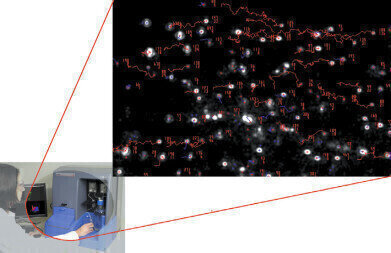News & Views
The Most Versatile Tool for Nanoparticle Characterisation Now with Added Benefits
Apr 06 2011
NanoSight debuted the Zeta Potential Analysis applying Z-NTA, particle-byparticle characterisation of surface charge, at Pittcon.
Zeta Potential Nanoparticle Tracking Analysis (Z-NTA) adds measurement of surface charge to simultaneous reporting of size, composition (light scattering intensity), fluorescence and count. As with NTA, the core of NanoSight’s world-accepted nanoparticle measurement systems, it collects data on a particle-by-particle basis. No other methodology comes close to providing such simultaneous, multiparameter nanoparticle characterisation.
Zeta potential is measured particle-by-particle, simultaneously for the complete sample population to provide data that is number weighted not intensity weighted. Size and light scattering intensity are also reported. Polydisperse and complex suspensions are readily characterised. No labelling is required but a fluorescence mode option is available to further differentiate suitable-labelled sub-populations. All data sets are validated by real time observation of particles moving under both electrophoretic and Brownian motion.
The user benefits are clear to define. Variations in zeta potential with size are analysed with positively and negatively charged particles being reported separately even when they exist together. Sub-populations of similar sized particles of different materials, differentiated by their propensity to scatter light, are separately reported and counted. As with size distribution measurement, changes in Zeta Potential distribution with pH, concentration and temperature may be studied. Similarly, aggregation and flocculation may be studied quantitatively in real-time. Suitable labelling can highlight one sub-population for analysis despite high background noise. With applications transcending the life sciences through the materials sciences, NanoSight have installed more than 300 systems worldwide as NTA-based characterisation becomes increasingly accepted as the technique to quantitatively study nanoparticles.
Digital Edition
Lab Asia 31.2 April 2024
April 2024
In This Edition Chromatography Articles - Approaches to troubleshooting an SPE method for the analysis of oligonucleotides (pt i) - High-precision liquid flow processes demand full fluidic c...
View all digital editions
Events
May 05 2024 Seville, Spain
InformEx Zone at CPhl North America
May 07 2024 Pennsylvania, PA, USA
May 14 2024 Oklahoma City, OK, USA
May 15 2024 Birmingham, UK
May 21 2024 Lagos, Nigeria





.jpg)












